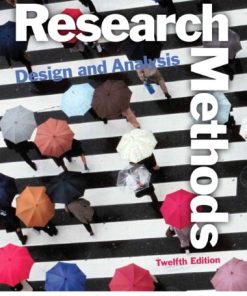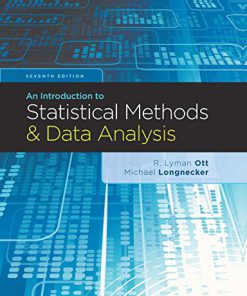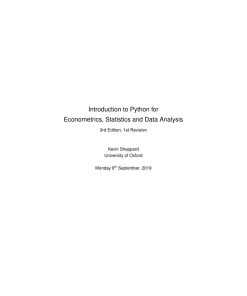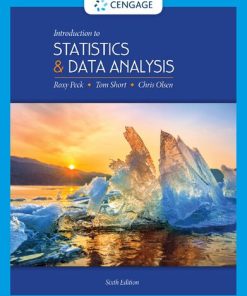(EBook PDF) Introduction to Research Methods and Data Analysis in Psychology 3rd edition by Darren Langdridge, Gareth Hagger Johnson 0273756885 9780273756880 full chapters
$50.00 Original price was: $50.00.$25.00Current price is: $25.00.
Introduction to Research Methods and Data Analysis in Psychology 3rd edition by Darren Langdridge, Gareth Hagger Johnson 0273756885 9780273756880 – Ebook PDF Instant Download/DeliveryISBN:
Full download Introduction to Research Methods and Data Analysis in Psychology 3rd edition after payment.

Product details:
ISBN-10 : 0273756885
ISBN-13 : 9780273756880
Author: Darren Langdridge, Gareth Hagger Johnson
This third edition of Introduction to Research Methods and Data Analysis in Psychology provides you with a unique, balanced blend of quantitative and qualitative research methods. Highly practical in nature, the book guides you, step-by-step, through the research process and is underpinned by SPSS screenshots, diagrams and examples throughout.
Introduction to Research Methods and Data Analysis in Psychology 3rd Table of contents:
Part 1 Introducing research methods
1 Starting out in research
Introduction
1.1 Why research?
1.2 A very brief history of science
1.3 Quantitative versus qualitative?
1.4 A brief introduction to methods in the social sciences
1.5 Planning research
Further reading
2 Variables: definitions and measurement
Introduction
2.1 Operationalising variables
2.2 Independent and dependent variables
2.3 The problem of error and confounding variables
2.4 Levels of measurement
2.5 Categorical and continuous variables
Further reading
3 Reliability, validity, sampling and groups
Introduction
3.1 Reliability
3.2 Validity
3.3 The role of replication in the social sciences
3.4 Populations and samples
3.5 The problem of sampling bias
3.6 Methods of sampling
3.7 Sample sizes
3.8 Control and placebo groups
Further reading
4 Collecting data 1: interviews and observation
Introduction
4.1 Interviewing
4.2 Types, purposes and structures of interviews
4.3 Interview techniques
4.4 Group discussions
4.5 Repertory grid techniques
4.6 Observation
4.7 Structured and non-participant observation
4.8 Participant observation
Further reading
5 Collecting data 2: questionnaires and psychometric tests
Introduction
5.1 Questionnaires
5.2 The first rule of questionnaire design: don’t reinvent the wheel
5.3 General principles, types and structure of questionnaires
5.4 Writing questions and measuring attitudes
5.5 Psychometrics
5.6 Reliability
5.7 Validity
5.8 Psychometric tests
Further reading
6 Collecting data 3: experimental and quasi-experimental designs
Introduction
6.1 The role of experiments in psychology
6.2 Types of experiment
6.3 Identifying four sources of error in experiments
6.4 Four ways to reduce error in experiments
6.5 Types of experimental design
6.6 Running an experiment
6.7 Describing an experiment: a note about causality
6.8 Returning to the basics of design
Further reading
7 E-research
Introduction
7.1 Types of e-research
7.2 A warning – what is the population?
7.3 E-research and online topics
7.4 E-research and offline topics
7.5 Ethical issues in e-research
Further reading
Part 2 Analysing quantitative data
8 Fundamentals of statistics
Introduction
8.1 Descriptive and inferential statistics
8.2 Measures of central tendency and dispersion
8.3 Probability
8.4 Levels of significance
8.5 The normal distribution
8.6 Understanding z-scores
8.7 Standard error
8.8 Parametric versus non-parametric tests
Further reading
9 Entering and manipulating data
Introduction
9.1 First steps with SPSS
9.2 The Data Editor window
9.3 Defining variables
9.4 Entering data
9.5 Saving and opening data files
9.6 Sorting and splitting files
9.7 Selecting cases
9.8 Recoding variables
9.9 Computing new variables
Further reading
10 Graphical representation and descriptive statistics
Introduction
10.1 Descriptive statistics
10.2 Simple and complex bar charts
10.3 Histograms
10.4 Pie charts
10.5 Box plots
10.6 Scattergrams
10.7 Editing charts
11 Bivariate analysis 1: exploring differences between variables
Introduction
11.1 Theoretical issues in inferential statistics
11.2 Introducing the t-test
11.3 Calculating an independent groups t-test
11.4 Calculating a related t-test
11.5 Introducing non-parametric tests of difference
11.6 Calculating a Mann–Whitney U-test
11.7 Calculating a Wilcoxon test
12 Bivariate analysis 2: exploring relationships between variables
Introduction
12.1 Introducing chi-square
12.2 Calculating chi-square
12.3 Introducing correlation coefficients
12.4 Calculating correlation coefficients
13 Analysis of variance (ANOVA)
Introduction
13.1 Terminology and techniques
13.2 Calculating a one-way ANOVA
13.3 Calculating a two-way ANOVA
13.4 Calculating a mixed design ANOVA
13.5 Non-parametric alternatives – Kruskal–Wallis and Friedman
14 Multivariate analysis of variance (MANOVA)
Introduction
14.1 When would you use MANOVA?
14.2 Introduction to MANOVA
14.3 Calculating a MANOVA
14.4 Running a discriminant function analysis
Further reading
15 Regression
Introduction
15.1 Terminology and techniques
15.2 Calculating multiple regression using SPSS
Further reading on statistics
Statistical test flowchart
16 Exploratory factor analysis (EFA)
Introduction
16.1 What is a latent variable?
16.2 Fundamentals of EFA
16.3 What is the difference between factor analysis and PCA?
16.4 Creating scale scores manually
Further reading
17 Introducing R and R commander
Introduction
17.1 What is R?
17.2 Installing new R libraries
17.3 The R commander
17.4 Importing data into R
17.5 Getting started with R code
17.6 Making comments
17.7 Basic R commands
17.8 Vectors
17.9 Large and small numbers
17.10 Save your code
17.11 Creating and saving a data frame
17.12 Graphs
17.13 Independent t-test
17.14 Related t-test
17.15 Mann–Whitney test
17.16 Wilcoxon test
17.17 Chi square
17.18 Correlation and linear regression
17.19 Multiple regression
17.20 One-way ANOVA
17.21 Two-way ANOVA
17.22 Repeated measures ANOVA
17.23 Reshaping wide format data into long format
17.24 Exploratory factor analysis
Further R resources
Further reading
Part 3 Analysing qualitative data
18 Fundamentals of qualitative research
Introduction
18.1 Philosophical underpinnings: the old paradigm
18.2 Philosophical underpinnings: the new paradigm
18.3 Revisiting the qualitative versus quantitative debate
18.4 Limitations of the new paradigm for the social sciences
18.5 Varieties of qualitative methods and analysis
Further reading
19 Transcribing, coding and organising textual data
Introduction
19.1 Purposes and principles of transcription
19.2 Systems of transcription
19.3 Transcription as analysis
19.4 Coding qualitative data
19.5 Thematic analysis
19.6 Organising and presenting the analysis of textual data
Further reading
20 Phenomenological research methods
Introduction
20.1 The fundamentals of phenomenology: philosophical issues
20.2 The fundamentals of phenomenology: methodological issues
20.3 Searching for meaning: phenomenological psychology and the Duquesne School
20.4 Searching for meaning: interpretative phenomenological analysis (IPA)
20.5 Strengths, limitations and debates
Further reading
21 Grounded theory
Introduction
21.1 Introducing grounded theory
21.2 Collecting data
21.3 The dynamic nature of meaning making
21.4 Coding
21.5 Memo-writing
21.6 Theory development
21.7 Strengths, limitations and debates
Further reading
22 Discourse analysis
Introduction
22.1 The turn to language
22.2 Approaches to the study of discourse
22.3 Discursive psychology
22.4 Foucauldian discourse analysis
22.5 Strengths, limitations and debates
Further reading
23 Life story and narrative research
Introduction
23.1 The turn to narrative
23.2 Selecting informants
23.3 Collecting data
23.4 Triangulation
23.5 Analysing life story data
23.6 Writing a life story
23.7 Narrative practice and form
23.8 Strengths, limitations and debates
Further reading
24 The use of computers in qualitative research
Introduction
24.1 Use of computers in qualitative research
24.2 Qualitative analysis software
24.3 Introducing qualitative analysis software
24.4 Fundamentals of using QDA software
24.5 Controversies and debates
Further reading
25 Mixed methods
Introduction
25.1 Similarities between methods
25.2 Four models of (sequenced) mixed methods
25.3 Four models of triangulated methods
25.4 Blended or ‘hybrid’ methods
25.5 Q method
25.6 Other hybrid methods
25.7 A final comment
Further reading
Resources: Q method
Part 4 Ethics and reporting fi ndings
26 The ethics and politics of psychological research
Introduction
26.1 Ethical fundamentals
26.2 BPS Code of Human Research Ethics principles
26.3 Respect for the autonomy and dignity of persons
26.4 Scientific value
26.5 Social responsibility
26.6 Maximising benefit and minimising harm
26.7 Other named issues in the Code of Human Research Ethics
26.8 Research with (non-human) animals
26.9 Equal opportunities
26.10 Politics and psychological research
26.11 Evaluation research
26.12 The need for balance
Further reading
27 Reporting and presenting findings
Introduction
27.1 The standard scientific report style
27.2 An example quantitative report (with commentary)
27.3 Writing up qualitative research
27.4 Writing skills
27.5 Presenting research – writing for publication
People also search for Introduction to Research Methods and Data Analysis in Psychology 3rd:
ways of data analysis in research
what are data analysis methods in research
what is introduction to research methods
what is data analysis in research methodology
introduction to research and research methods
Tags:
Introduction,Research Methods,Data Analysis,Psychology,Darren Langdridge,Gareth Hagger Johnson
You may also like…
Business & Economics - Econometrics
Introduction to Python for Econometrics, Statistics and Data Analysis
History & Research
Introduction to Research Methods in Psychology 4th Edition Dennis Howitt












